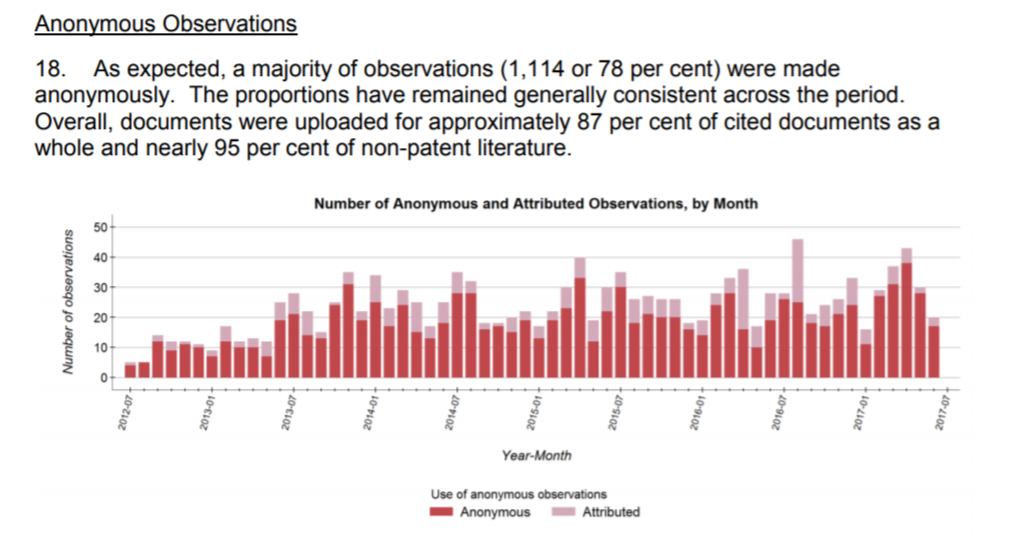PCT國際階段之第三方意見調查
PCT國際專利申請過程中,對於特定專利之可專利性的第三方挑戰,大多數在國家專利局或區域性專利局階段提出。至於在國際階段提出的第三方挑戰的情況如何,WIPO(世界智慧財產權組織)近期發布了一份整理資料。
Most third party challenges to patentability occur in front of national or regional patent offices. WIPO recently released a summary of data regarding the extent to which third parties are challenging patentability at the international level.
專利申請程序中,第三方是指專利申請方、審查主管機關以外的公眾。在PCT國際階段,公眾可提出第三方意見 (Third Party Observation,TPOs),但必須與系爭專利之新穎性(novelty)及進步性(inventive step)有關,而非專利不明確(indefiniteness)、缺乏可實施性(lack of enablement)、或缺乏支持(lack of support)等其他領域事由。透過ePCT系統提交的第三方意見,每次可引用最多10筆文件,次數不限,可以包括對於引述文件之相關性說明,每筆文件說明最多5000個字母。
The observations must relate to novelty and inventive step, but not other grounds such as indefiniteness, lack of enablement or lack of support. Any member of the public can file Third Party Observations (“TPOs”) against a PCT application during the international phase. Observations can include an explanation of relevance of the cited documents up to a maximum of 5000 characters for each cited document. The observations are filed through the ePCT system. A maximum of ten documents can be cited per observation (multiple observations are permitted).
國際階段提出TPOs:更經濟實惠的選擇

TPOs的受理期間,自國際公開(Internal publication)日開始,到第一優先權日起算28個月為止,專利申請人有機會回應每個第三方意見。
上述程序的目的,乃提供一具經濟效益的系統,協助國際或各國專利局,能因而注意到相關先前技術。若該先前技術不太可能由個別專利局發現,那麼在PCT國際階段由第三方一次提交該先前技術,相較於在各國專利局逐一提出第三方意見,前者可說尤其經濟實用。要等著看所反對專利在PCT國家階段申請情況的第三方,必須追蹤所述先前技術在各國、及個別申訴情況。
TPOs are accepted from time of international publication until 28 months from the priority date. The applicant has an opportunity to respond to each observation. The aim of this process is to provide a cost-effective system to assist international and national patent offices to become aware of pertinent prior art. If the prior art is unlikely to be located by an individual patent office, then it may be particularly practical and cost-effective for a third party to file the prior art one time at the PCT international level, rather than case-by-case in national offices. For a third party to wait and see how prosecution unfolds at the PCT national stage may necessitate monitoring of multiple national filings and then multiple individual filings of the prior art.
若PCT專利申請案另有其相關聯的美國專利申請案審查中(co-pending),則在PCT案提交第三方意見,可促使專利申請人對其關聯美國專利申請案,主動提交IDS(資訊揭露陳報書)。
If a separate US application is co-pending with the PCT, then filing a TPO can be a useful technique to cause the applicant to file the prior art in the separate US application in a US information disclosure statement.

從專利申請人的角度來看,TPOs也有助於專利人在專利申請過程中,就發明的可專利性,能提早做出正確的評估。
From the point of view of the applicant, a TPO can also be helpful by allowing the applicant to make better-informed decisions regarding the patentability of inventions earlier on in the patenting process.
WIPO自2012年7月起免費受理TPOs至今屆滿5年,2018年1月底發布統計(WIPO Circular 1527) 分析系統5年來的使用情況。
It has been more than 5 years since WIPO introduced the process. On January 31, 2018, WIPO published a circular analyzing the use of the system in its first 5 years.
僅0.15%PCT專利申請案會收到TPO
資料分析結果顯示,TPOs措施推行後第一個5年期間,系統總計受理1,422筆TPOs,所針對的國際專利申請案為1,394個,約佔同期國際公開的專利申請案0.15%(僅45個TPOs遭駁回,理由大多是可以修改的錯誤)。
WIPO分析發現,使用TPO程序的頻率高低,與專利申請的發明領域有關,最常提出的TPOs的是高分子化學(macromolecular chemistry)、及食品化學(food chemistry fields)領域,其中一種解釋為TPOs僅限於針對新穎性(novelty)及進步性(inventive step)提出意見;另一解釋則是,異議第三方除了在提交TPOs之初可以簡單陳述外,後續無法參與進一步審議過程。
The process appears to be in little use. A total of 1,422 TPOs were accepted in relation to 1,394 international applications through the system. This represents just around 0.15% of published international applications. WIPO found that the frequency of use of the process appears to depend on the field of the invention, with the highest use noted in macromolecular chemistry and food chemistry fields. One explanation for these findings is that TPOs are limited to only circumstances where novelty and inventive step are at issue. Another is that the process is limiting in that third parties cannot participate in the proceedings beyond the initial filing of the observations (which allow for a very brief argument).
TPOs提交後,系爭專利的申請人能就所述先前技術任意提出回應。儘管如此,實際上多數專利人不會在國際階段有所行動,其中僅4.5%專利申請人做出回應,顯示多數專利申請人傾向在國家階段(national stage)處理先前技術問題,等國家/區域專利局如何引用此些先前技術。
After the initial observations are filed, the applicant would then be free to characterize the prior art however it wishes. That said, it appears that most applicants do not take any action at the PCT level in response to observations. Only 4.5% of applicants filed a response to observations. It appears that most applicants prefer to deal with prior art at the national stage, once they see how the prior art is characterized by national/regional patent offices.

WIPO發現,多數TPOs中引述文件數量只有1筆,平均引用文件3.8筆。就此而言,TPOs較出現單一先前技術非常接近的情況。
WIPO found that the most common number of cited documents in an observation is just one. The average is 3.8 citations per observation. As such, this process appears to be most commonly employed where there is a single piece of prior art (presumably the prior art is arguably anticipatory or very close).
截止前提交TPO有利有弊
有趣的是WIPO分析指出,第三方往往會在受理截止期限前才提交TPOs,據統計33% TPO是在最後一周送出,WIPO提出建議,那些拖到最後才提出的TPOs,不但在國際申請案的國際初步審查(international preliminary examination)來不及納入考慮,專利申請人也來不及做出回應,且若國際局駁回(reject)內容有誤的TPOs時,亦無法在期限前要求修正版本。
Interestingly, the circular noted that there is a great tendency for third parties to leave the filing of their observations until the last minute, with around 33% of TPOs received in the final week. The circular cautioned that in such instances the late prior art cannot be considered for international preliminary examination. This also prevents applicants from filing a response and the International Bureau from rejecting defective observations and requesting corrected versions before the expiration of time.
然拖延提交TPOs的原因之一,可能是異議方不希望專利申請人及時注意到申請案不足之處,而有時間可以回應修改。若異議方要讓國家專利局注意到先前技術,卻毋須在國際階段加以分析,最後才提交TPOs看來不失為一個好方法。
One explanation for this tendency may be that third parties do not want to alert applicants of deficiencies in their application at a time where it is possible to take corrective action at the international stage. Filing a last minute observation appears to be a good way for a third party to flag prior art for national offices, without analysis at the international stage.
概括而言,PCT專利申請程序的TPOs,是有異議的第三方可採取的有效方法,用以提早指出任何申請的專利可能不具新穎性及進步性,儘管使用頻率低,TPOs仍有相當用處。一旦發現高度相關、此前已有的先前技術,別忘了可利用TPOs這種經濟方法,讓個別專利局早期就注意到所述先前技術。
In summary, TPOs in the PCT can be an effective way for a third party to indicate early that a patent application may not be novel and inventive. Although, the frequency with which TPOs are filed appears to be low, TPOs may nonetheless have some usefulness. TPO’s should be kept in mind when highly relevant, anticipatory prior art is located and the third party wants a cost effective way to flag the prior art for patent offices at an early time point.
【參考資料來源】
- Challenging PCT Patent Applications: Filing Third Party Observations at the International Stage
- PCT國際專利申請之第三方意見程序運用情況》分析報告
- 以PCT申請案作為我國申請案可行性研議